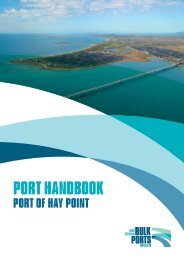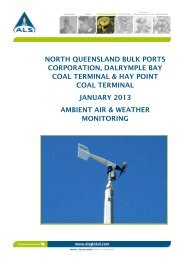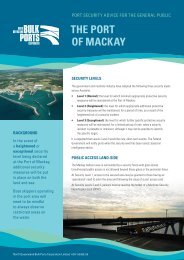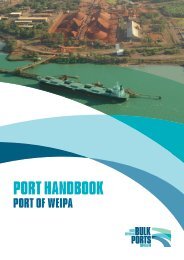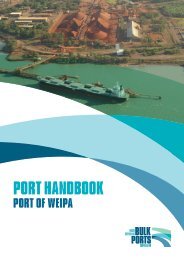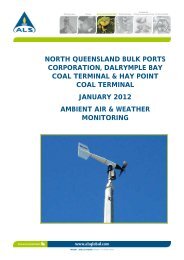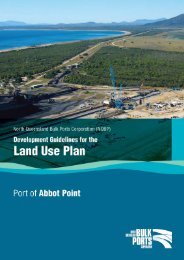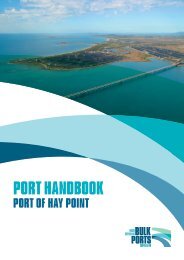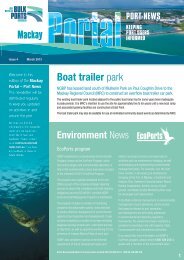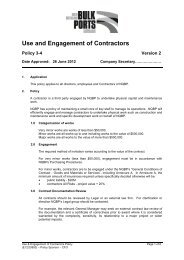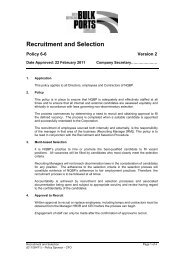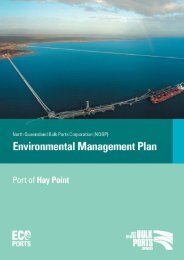Terms of Reference - North Queensland Bulk Ports Corporation
Terms of Reference - North Queensland Bulk Ports Corporation
Terms of Reference - North Queensland Bulk Ports Corporation
- No tags were found...
Create successful ePaper yourself
Turn your PDF publications into a flip-book with our unique Google optimized e-Paper software.
• location and abundance <strong>of</strong> any known exotic or weed pest plant species.Highlight sensitive or important vegetation types, including any marine, littoral andsubtidal zone and riparian vegetation, and their value as habitat for fauna andconservation <strong>of</strong> specific rare floral and faunal assemblages or community types.Describe the location and extent <strong>of</strong> listed plants (including marine plants) andsignificant habitats within any land to be filled or reclaimed.The description should contain a review <strong>of</strong> published information regarding theassessment <strong>of</strong> the significance <strong>of</strong> the vegetation to conservation, recreation, scientific,educational and historical interests.Potential impacts and mitigation measuresDescribe the potential environmental impacts to the ecological values <strong>of</strong> the areaarising from the construction, operation and decommissioning <strong>of</strong> the project includingclearing, salvaging or removing vegetation. Discuss the indirect effects on remainingvegetation. Consider short- and long-term effects and comment on whether the impactsare reversible or irreversible.For all components <strong>of</strong> the project, include:• a description <strong>of</strong> the potential impacts that clearing vegetation will have on listedspecies and communities in the extent <strong>of</strong> the proposed vegetation clearing• actions <strong>of</strong> the project or likely impacts that require an authority under the NC Act, orwould be assessable development for the purposes <strong>of</strong> the VM Act• any management actions to minimise vegetation disturbance and clearance• a discussion <strong>of</strong> the ability <strong>of</strong> identified vegetation to withstand any increasedpressure resulting from the project and any measures proposed to mitigate potentialimpacts• a description <strong>of</strong> the methods to ensure rapid rehabilitation <strong>of</strong> disturbed areasfollowing construction, including the species chosen for revegetation, which shouldbe consistent with the surrounding associations• details <strong>of</strong> any post-construction monitoring programs• a discussion <strong>of</strong> the potential environmental harm on flora due to any alterations tothe local surface and groundwater environment with specific reference to impacts onriparian vegetation or other sensitive vegetation communities• a description <strong>of</strong> any foreseen impacts that increase the susceptibility <strong>of</strong> ecologicalcommunities and species to the impacts <strong>of</strong> climate change.Weed management strategies are required for containing existing weed species (forexample, parthenium and other declared plants) and ensuring no new declared plantsare introduced to the area. Refer to the MRC draft pest management plan 2011–2014and any strategies and plans recommended for the project area by Biosecurity<strong>Queensland</strong>. Discuss the strategies in accordance with provisions <strong>of</strong> the LandProtection (Pest and Stock Route Management) Act 2002 (Qld) in the main body <strong>of</strong> theEIS and in the pest management plan within the project EMPs.Outline how all flora management measures will be implemented in the project EMPs.Contents <strong>of</strong> the EISDudgeon Point Coal Terminals Project<strong>Terms</strong> <strong>of</strong> reference for an environmental impact statement- 39 -



